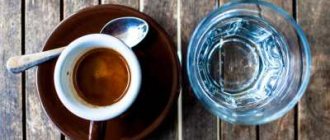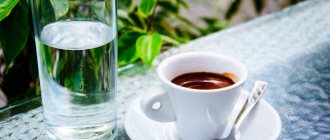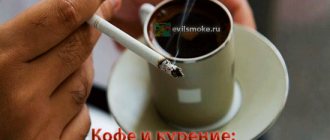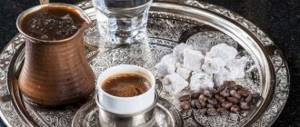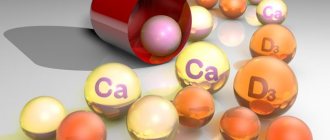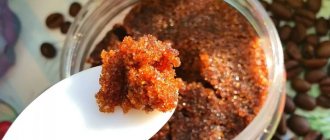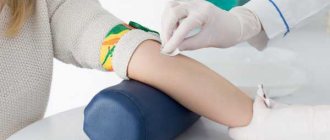Does coffee make teeth yellow?
All people's teeth turn yellow, but for everyone the process occurs with different intensity. The degree of pigment penetration depends on the following factors:
- Smoothness and density of the enamel layer of teeth. People have different densities of tooth enamel. These properties are inherited. Some people have smooth enamel to which nothing sticks. Others have a porous, rough surface that traps pigments, causing brown or yellow spots to quickly appear. Therefore, people can safely and without restrictions drink the drink, but others cannot afford it.
- Content of organic acids in the drink. There is evidence that some varieties contain more organic acids, which destroy enamel and dentin. This is what makes Robusta different. Mocha and Arabica contain much less of this substance. For lovers of the Robusta variety, the enamel darkens faster.
- Number of cups drunk per day. To prevent your teeth from changing color, you should drink no more than two cups of black coffee daily and take regular care of your oral cavity.
Many people have naturally yellowish teeth, and the pigments contained in coffee enhance it. Smoking along with drinking coffee increases the rate of darkening of the enamel.
Why do teeth turn yellow and dark from coffee?
Does coffee drink make teeth yellow?
Drinking a small amount of the drink will not cause a big change in the color of your teeth. Since coffee beans contain natural dyes, it becomes more difficult for those who drink coffee excessively to keep their teeth white.
In this case, tooth enamel staining occurs due to microcracks formed in it. If you take care of your teeth and take care of them, there is no need to worry about discoloration.
- Those who like to drink hot coffee outdoors in cool weather or combine coffee with ice cream should be careful. Contrasting temperature is one of the causes of enamel destruction. Coffee, getting into the cracks formed, gives the teeth an undesirable shade.
- After any meal, plaque remains on the teeth. If it is not removed promptly, it accumulates on the surface of the teeth. This layer, like a sponge, is saturated with the dark color of coffee, and it is this layer that gives the enamel its yellowness.
Why do stains appear on teeth?
It’s not just this drink that causes stains on your teeth. Black tea, red wine, colored soda and fruit juices have the same properties. If the enamel is healthy and smooth, then dark spots practically do not form. Pigments are deposited in porous enamel, as well as in its chips and cracks. For this reason, spots appear. Freeze-dried coffee has a greater coloring effect compared to natural coffee. If your teeth have darkened, then it’s time to think about their health and see a dentist to strengthen the enamel.
Is coffee harmful to teeth or is it just a cosmetic defect?
The drink itself is not harmful. On the contrary, the substances contained in it suppress the activity of bacteria that cause caries. But this only applies to natural and unsweetened coffee. Sugar has a negative effect on enamel. It creates a nutrient medium for the proliferation of carious microorganisms. The drink is usually drunk hot. And high temperatures adversely affect the integrity of the enamel, forming microcracks. Also, the negative effect increases with temperature changes. Therefore, it is not advisable to drink coffee with ice cream, wash it down with cold water, or drink it outside in cold weather.

How to whiten your teeth
Approximately 85% of plaque is removed with a regular brush and toothpaste. But this only applies to teeth with healthy enamel and if plaque is removed daily. If you don't brush your teeth regularly and don't take good care of your oral cavity, hard plaque forms, which can only be removed with the help of a dentist. Currently, there are many whitening pastes, folk remedies to combat plaque, and professional types of dental cleanings.
There are many tooth whitening toothpastes, for example:
- Colgate Optic White.
- "New Pearl - Whitening."
- "Blendamed 3D White LUXE".
- "SILCA Arctic White".
- "ROCS - Sensational whitening."
These products, when used regularly, are quite effective in combating dye deposits. To enhance the effect of the paste, you can use an electric brush. And also use special products to remove plaque.
These include:
- whitening gel;
- whitening strips;
- sticks;
- trays with whitening composition;
- pencil.
These products are used to remove fresh plaque. To remove yellow plaque, many traditional methods are used. The most popular of them:
- turmeric powder mixed with a little water;
- the inside of a banana skin;
- tea tree oil;
- strawberry, pear or apple pulp;
- lemon juice;
- hydrogen peroxide three percent;
- powdered activated carbon;
- baking soda.
These substances are simply wiped over the surface of the teeth or the enamel is treated with them using a brush. If you are unable to cope with plaque on your own, it is recommended to contact a dental clinic.
The dental clinic offers various plaque removal procedures:
- chemical bleaching using high concentrations of hydrogen peroxide;
- ultrasonic removal;
- clarification using air-imaging systems;
- laser photobleaching;
- ultraviolet Zoom whitening with activating gel.
People with a thin layer of enamel or increased sensitivity of teeth should refrain from such activities.
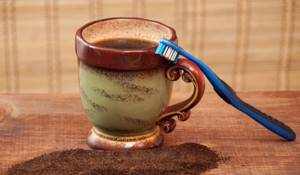
How to remove coffee stains from teeth
Folk remedies
If stains have already appeared, there are several ways to deal with them or at least reduce the shade.
The following methods will help reduce the effect of coffee on your teeth.
Using a cotton pad or brush, rub baking soda into the enamel. Then rinse your mouth with plenty of warm water.
Grind the activated carbon tablet to a powder. Then brush your teeth and rinse your mouth thoroughly.
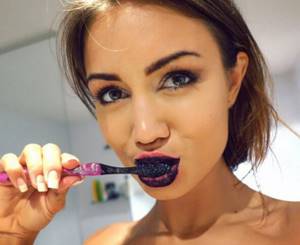
Hydrogen peroxide does an excellent job of removing plaque and yellowness. But be careful. The product can damage the enamel. At the first suspicion of a problem, use of peroxide should be stopped. You need to use the product to remove stains for at least two weeks. To do this, moisten a cotton pad with it and thoroughly wipe the teeth.
It is useful to use apple, lemon peel or strawberry for stains. First, you need to rub the crushed fruit on your teeth, and then brush them with a toothpaste containing fluoride. This method can be used no more than twice a month. Otherwise, the acids contained in fruits will damage tooth enamel.
Despite the benefits and apparent safety of folk remedies, you should be careful when using them. Therefore, before starting treatment, it is necessary to consult a doctor.
Interesting! The effect of coffee on blood pressure: increases or decreases it
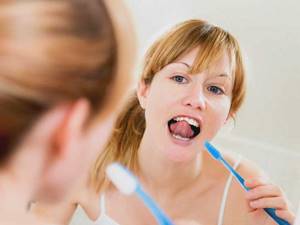
Pharmacy products
Medicines purchased at the pharmacy will also help to cope with yellowness.
Use a paste with a whitening effect in combination with a brush with stiff bristles.
An electric brush can easily remove plaque that has recently appeared. The device works faster than manual cleaning, and therefore quickly eliminates the problem. Pay attention to the stubble. It shouldn't be too hard. Otherwise, you can damage the enamel and gums.
Whitening strips are used for at least two weeks. They are glued to problem areas of the enamel and kept for about 30 minutes. The downside of the product is its high cost.
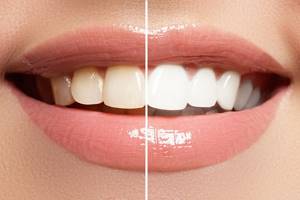
Gels with a whitening effect are considered effective and at the same time safe ways to cope with yellowness. Before applying the gel, your teeth must be thoroughly cleaned. Apply a small amount of product to a clean surface. Then you should wait until the drug dissolves. The procedure is repeated for two weeks.
The sticks gently and carefully whiten the enamel. But they are used to prevent plaque, and not to fight it. Therefore, they should be used immediately after drinking espresso.
Whitening trays are effective in fighting stains. They can even handle old yellow stains. It is necessary to use the method strictly following the instructions for use. Overuse of mouthguards destroys enamel.
You can remove plaque at home only after consulting a doctor.
He will be able to advise you on the best method to suit your teeth specifically.
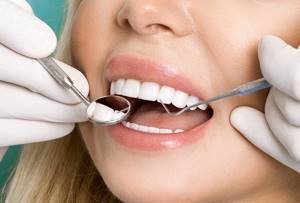
How to avoid plaque
There are ways to reduce plaque buildup when drinking coffee drinks.
- If you drink the drink with milk or cream, no sediment will form. This happens because milk protein binds coloring pigments. Plant-based milk substitutes do not have this property. In addition, calcium contained in dairy products strengthens dental tissue.
- Drink a drink through a straw. This will reduce contact with liquid and reduce plaque formation.
- Drink a drink with reduced caffeine content. It also contains less coloring polyphenols.
- After drinking the drink, rinse your mouth with warm water.
- Drink coffee quickly to reduce the duration of contact of the enamel with the dye.
- The amount of polyphenols in the drink depends on the preparation method. Coffee prepared in an espresso machine contains less of them than coffee brewed in a Turk.
Taking precautions will help avoid plaque deposition.
How to drink coffee so your teeth don't turn yellow?
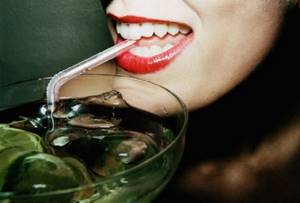
As mentioned above, the main reason for discoloration of enamel is plaque and microcracks.
Therefore, only thorough prevention will help prevent yellowing of teeth:
- Avoid contrasting coffee with ice cream or cold water.
- Brush your teeth after every drink.
- Use dental floss to thoroughly clean the crevices between your teeth.
- If you don’t have the conditions to brush your teeth after coffee, eat an apple. It perfectly cleanses the surface of teeth from fresh plaque stained by drinking coffee.
- Chew gum with a whitening effect after drinking coffee. This will help to at least briefly delay the proliferation of microbes that contribute to the appearance of plaque on the teeth.
- Use a teeth rinse for the same purpose.
- Wash your coffee with soft water. It will wash away the pigment and prevent the appearance of unsightly plaque.
Drinking coffee after a dentist appointment
Dental patients often ask whether it is allowed to drink coffee after dental procedures. A visit to the dentist is, first of all, a psychological stress. After it you want to relax and do something nice for yourself. Restrictions on food and drink depend on the type of dental procedure.
Removal of a tooth
Since tooth extraction is a surgical operation, it leaves a wound. To ensure that it heals well and does not cause bleeding or other complications, the dentist recommends not eating or drinking with caution for some time after the operation. These restrictions apply to all drinks.
You should not drink coffee immediately after removal for the following reasons:
- a hot drink provokes bleeding due to the dissolution of the blood clot;
- caffeine dilates peripheral blood vessels,
- blood pressure increases, increasing bleeding from the wound;
- If you drink on an empty stomach, the production of gastric juice increases; in case of heartburn, it causes irritation of the mucous membrane in the mouth.
You are allowed to drink coffee only three hours after tooth extraction.
Implantation
Installing dentures is a major surgical procedure. Caffeine consumption significantly increases bleeding in the area where the prosthesis is implanted, raising blood pressure. Therefore, this drink is allowed to be drunk no earlier than after five days.
Have you noticed the appearance of plaque on your teeth from coffee?
Yes
No
Teeth whitening
For the first two weeks, it is recommended to exclude coloring substances from the diet, including black coffee and even milk. Caution is required in the first two days. To prevent teeth from turning yellow again after each drink after the procedure, they should be cleaned with hygienic paste and a brush for preventive purposes.
Cleaning teeth enamel
After whitening, it is advisable to exclude drinks with dyes from the diet so that tooth enamel remains white. If it is not possible to refuse completely, then you are allowed to drink coffee after two weeks from the date of the procedure. It is better to add milk or cream to the drink, but you should exclude sugar. After drinking, you should rinse your mouth with mouthwash or brush your teeth.
